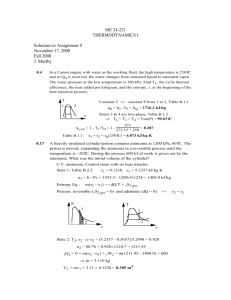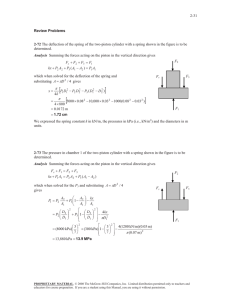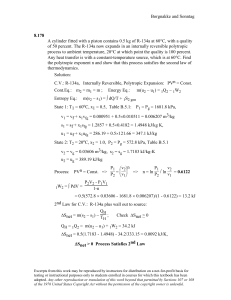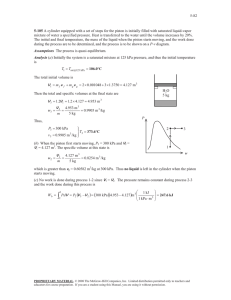Extra Problems for Chapter 8
advertisement
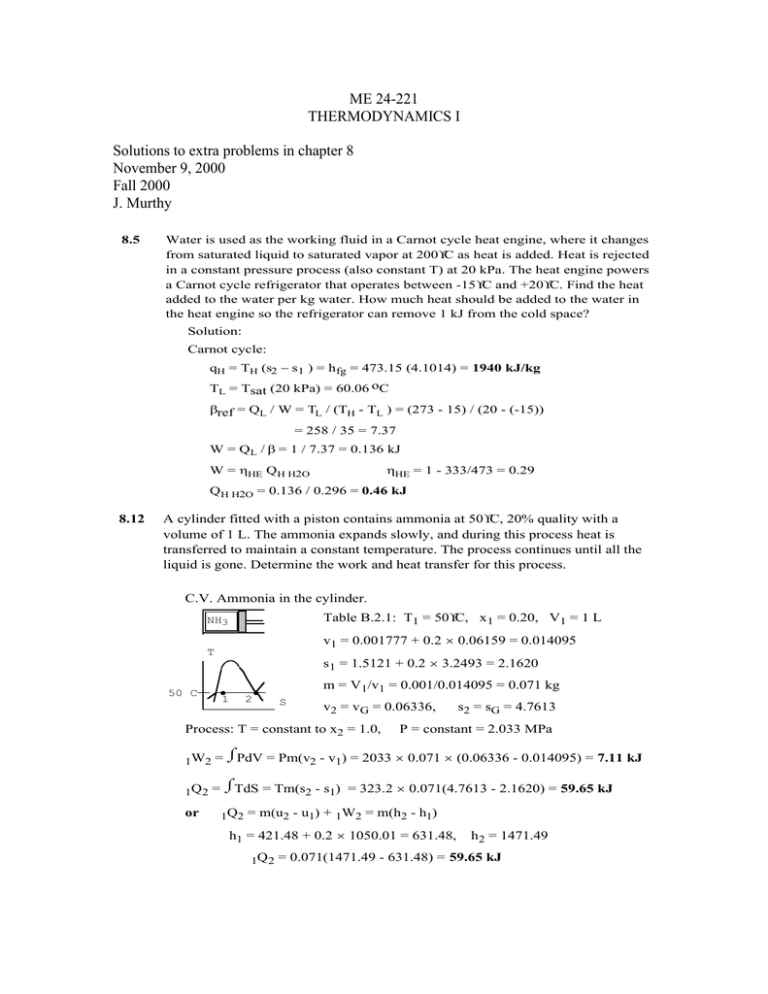
ME 24-221 THERMODYNAMICS I Solutions to extra problems in chapter 8 November 9, 2000 Fall 2000 J. Murthy 8.5 Water is used as the working fluid in a Carnot cycle heat engine, where it changes from saturated liquid to saturated vapor at 200°C as heat is added. Heat is rejected in a constant pressure process (also constant T) at 20 kPa. The heat engine powers a Carnot cycle refrigerator that operates between -15°C and +20°C. Find the heat added to the water per kg water. How much heat should be added to the water in the heat engine so the refrigerator can remove 1 kJ from the cold space? Solution: Carnot cycle: qH = TH (s2 − s 1 ) = hfg = 473.15 (4.1014) = 1940 kJ/kg TL = Tsat (20 kPa) = 60.06 oC βref = QL / W = TL / (TH - TL ) = (273 - 15) / (20 - (-15)) = 258 / 35 = 7.37 W = QL / β = 1 / 7.37 = 0.136 kJ ηHE = 1 - 333/473 = 0.29 W = ηHE Q H H2O Q H H2O = 0.136 / 0.296 = 0.46 kJ 8.12 A cylinder fitted with a piston contains ammonia at 50°C, 20% quality with a volume of 1 L. The ammonia expands slowly, and during this process heat is transferred to maintain a constant temperature. The process continues until all the liquid is gone. Determine the work and heat transfer for this process. C.V. Ammonia in the cylinder. Table B.2.1: T1 = 50°C, x 1 = 0.20, V1 = 1 L NH3 v1 = 0.001777 + 0.2 × 0.06159 = 0.014095 T 50 C s 1 = 1.5121 + 0.2 × 3.2493 = 2.1620 m = V1/v1 = 0.001/0.014095 = 0.071 kg 1 2 S v2 = vG = 0.06336, Process: T = constant to x2 = 1.0, s2 = sG = 4.7613 P = constant = 2.033 MPa ⌠ 1W2 = ⌡PdV = Pm(v2 - v1) = 2033 × 0.071 × (0.06336 - 0.014095) = 7.11 kJ ⌠ 1Q 2 = ⌡TdS = Tm(s2 - s1) = 323.2 × 0.071(4.7613 - 2.1620) = 59.65 kJ or 1Q2 = m(u2 - u1) + 1W2 = m(h2 - h1) h1 = 421.48 + 0.2 × 1050.01 = 631.48, h2 = 1471.49 1Q 2 = 0.071(1471.49 - 631.48) = 59.65 kJ 8.14 A cylinder fitted with a frictionless piston contains water. A constant hydraulic pressure on the back face of the piston maintains a cylinder pressure of 10 MPa. Initially, the water is at 700°C, and the volume is 100 L. The water is now cooled and condensed to saturated liquid. The heat released during this process is the Q supply to a cyclic heat engine that in turn rejects heat to the ambient at 30°C. If the overall process is reversible, what is the net work output of the heat engine? C.V.: H2O, 1‡3, this is a control mass: Continuity Eq.: m1 = m3 = m P 2 3 1 m(u3-u1) = 1Q3 − 1W3; Energy Eq.: Process: P = C => 1W3 = ∫ P dV = Pm(v3-v1) v o State 1: 700 C, 10 MPa, V1 = 100 L Table B.1.4 v1 = 0.04358 m3/kg => m = m1 = V1/v1 = 2.295 kg h1 = 3870.5 kJ/kg, s1 = 7.1687 kJ/kg K State 3: P3 = P1 = 10 MPa, x3 = 0 T 3 1 2 Table B.1.2 s h3 =hf = 1407.5 kJ/Kg, s3 = sf = 3.3595 kJ/Kg K 1Q 3 = m(u3-u1) + Pm(v3 - v1) = m(h3 - h1) = -5652.6 kJ Heat transfer to the heat engine: -1Q 3 QH = -1Q3 = 5652.6 kJ Take control volume as total water and heat engine. Process: Rev., H.E. ∆Snet = 0 ; TL = 30oC 2nd Law: ∆Snet = m(s3 - s1) - Qcv/TL ; Qcv = To m(s3 - s1) = -2650.6 kJ => QL = -Qcv = 2650.6 kJ Wnet = WHE = QH - QL = 3002 kJ QL Tamb WHE 8.22 A heavily-insulated cylinder fitted with a frictionless piston contains ammonia 6°C, 90% quality, at which point the volume is 200 L. The external force on th piston is now increased slowly, compressing the ammonia until its temperature reaches 50°C. How much work is done on the ammonia during this process? Solution: C.V. ammonia in cylinder, insulated so assume adiabatic Q = 0. Cont.Eq.: m2 = m1 = m ; Entropy Eq.: Energy Eq.: m(u2 − u1) = 1Q2 − 1W2 m(s2 − s1) = ∫ dQ/T + 1S2 gen State 1: T1 = 6oC, x1 = 0.9, V1 = 200 L = 0.2 m3 Table B.2.1 saturated vapor, P 1 = Pg = 534 kPa v1 = vf + x1vfg = 0.21166 m3/kg, u1 = uf + x1ufg = 207.414 + 0.9×1115.3 = 1211.2 kJ/kg s1 = sf + x1sfg = 0.81166 + 0.9×4.4425 = 4.810 kJ/kg-K, m1 = V1/v1 = 0.2 / 0.21166 = 0.945 kg Process: 1‡2 Adiabatic 1Q2 = 0 & Reversible 1S2 gen = 0 => s1 = s2 State 2: T2 = 50oC, s2 = s1 = 4.810 kJ/kg-K superheated vapor, interpolate in Table B.2.2 v2 = 0.0684 m3/kg, => P2 = 1919 kPa, h2 = 1479.5 kJ/kg u2 = h2 - P2v2 = 1479.5 - 1919×0.0684 = 1348.2 kJ/kg P T 2 2 1 1 v s Energy equation gives the work as 1W2 = m(u1 - u2) = 0.945 ( 1211.2 - 1348.2) = -129.4 kJ 8.27 An insulated cylinder/piston contains R-134a at 1 MPa, 50°C, with a volume of 100 L. The R-134a expands, moving the piston until the pressure in the cylinder has dropped to 100 kPa. It is claimed that the R-134a does 190 kJ of work against the piston during the process. Is that possible? C.V. R-134a in cylinder. Insulated so assume Q = 0. State 1: Table B.5.2, s1 = 1.7494, v1 = 0.02185, u1 = 431.24 - 1000×0.02185 = 409.4, m = V1/v1 = 0.1/0.02185 = 4.577 kg m(u2 - u1) = 1Q2 - 1W2 = 0/ - 190 ⇒ u2 = 367.89 kJ/kg Energy Eq.: State 2: P2 , u2 ⇒ Table B.5.2: T2 = -19.25°C ; s2 = 1.7689 kJ/kg K ⌡dQ/T + 1S2,gen = 1S2,gen = 0.0893 kJ/K m(s2 - s1) = ⌠ Entropy Eq.: This is possible since 1S2,gen > 0/ P s=C 1 T 1 2 2 v 8.29 s A mass and atmosphere loaded piston/cylinder contains 2 kg of water at 5 MPa, 100°C. Heat is added from a reservoir at 700°C to the water until it reaches 700°C. Find the work, heat transfer, and total entropy production for the system and surroundings. C.V. Water. Process: P = const. so 1 W2 = P(V2 - V1) U2 - U1 = 1Q2 - 1W2 or 1Q2 = H2 - H1 = m(h2 - h1) P 1 T 2 v 2 1 v 1Q 2 = 2(3900.1 - 422.72) = 6954.76 kJ 1 W2 = 1Q2 - m(u2 - u1) = 874.6 kJ B.1.4: h1 = 422.72, u1 = 417.52 s1 = 1.303, v1 = 0.00104 B.1.3: h2 = 3900.1, u2 = 3457.6 s2 = 7.5122, v2 = 0.08849 ⌠dQ/T + 1S2 gen = 1Q2/Tres + 1S2 gen m(s2 - s1) = ⌡ 1S 2 gen = m(s2-s1) -1Q2/Tres = 2(7.5122 - 1.303) - 6954/973 = 5.27 kJ/K 8.41 A large slab of concrete, 5 × 8 × 0.3 m, is used as a thermal storage mass in a solar-heated house. If the slab cools overnight from 23°C to 18°C in an 18°C house, what is the net entropy change associated with this process? C.V.: Control mass concrete. V = 5 × 8 × 0.3 = 12 m3 m = ρV = 2300 × 12 = 27600 kg 1Q 2 = mC∆T = 27600 × 0.65(-5) = -89700 kJ ∆SSYST = mC ln T2 T1 = 27600 × 0.65 ln 291.2 = -305.4 kJ/K 296.2 ∆SSURR = -1Q2/T0 = +89700/291.2 = +308.0 kJ/K ∆SNET = -305.4 + 308.0 = +2.6 kJ/K 8.44 A hollow steel sphere with a 0.5-m inside diameter and a 2-mm thick wall contains water at 2 MPa, 250°C. The system (steel plus water) cools to the ambient temperature, 30°C. Calculate the net entropy change of the system and surroundings for this process. C.V.: Steel + water. This is a control mass. mSTEEL = (ρV)STEEL = 8050 × (π/6)[(0.504)3 - (0.5)3] = 12.746 kg ∆USTEEL = (mC)STEEL(T2 - T1) = 12.746 × 0.48(30 - 250) = -1346 kJ VH2O = (π/6)(0.5)3, m = V/v = 6.545×10-2/0.11144 = 0.587 kg v2 = v1 = 0.11144 = 0.001004 + x2 × 32.889 => x 2 = 3.358×10-3 u2 = 125.78 + 3.358×10-3 × 2290.8 = 133.5 s2 = 0.4639 + 3.358×10-3 × 8.0164 = 0.4638 ∆UH 1Q 2 2O = mH2O(u2 - u1)H2O = 0.587(133.5 - 2679.6) = -1494.6 = -1346 + (-1494.6) = -2840.6 ∆STOT = ∆SSTEEL + ∆SH2O = 12.746 × 0.48 ln (303.15 / 523.15) + 0.587(0.4638 - 6.545) = -6.908 kJ/K ∆SSURR = -1Q2/T0 = +2840.6/303.2 = +9.370 kJ/K ∆SNET = -6.908 + 9.370 = +2.462 kJ/K 8.47 Consider a Carnot-cycle heat pump having 1 kg of nitrogen gas in a cylinder/piston arrangement. This heat pump operates between reservoirs at 300 K and 400 K. At the beginning of the low-temperature heat addition, the pressure is 1 MPa. During this processs the volume triples. Analyze each of the four processes in the cycle and determine a. The pressure, volume, and temperature at each point b. The work and heat transfer for each process T 4 3 T1 = T2 = 300 K, T3 = T4 = 400 K, P1 = 1 MPa, V2 = 3 × V1 a) P2V2 = P1V1 => P2 = P1/3 = 0.3333 MPa mRT1 1 × 0.2968 × 300 = = 0.08904 m3 V1 = P1 1000 N2 2 1 s V2 = 0.26712 m3 k 400 P3 = P2(T3/T2)k-1 = 0.3333 3.5 = 0.9123 MPa 300 V 3 = V2 × P2 P3 × T3 T2 = 0.26712 × 0.3333 400 × = 0.1302 m3 0.9123 300 k 400 P4 = P1(T3/T1)k-1 = 1 3.5 = 2.73707 MPa 300 V 4 = V1 × P1 P4 × T4 T1 = 0.08904 × 1 400 × = 0.04337 m3 2.737 300 b) 1W2 = 1Q2 = mRT1 ln (P1/P2) = 1 × 0.2968 × 300 ln(1/0.333) = 97.82 kJ 3W4 = 3Q 4 = mRT3 ln(P3/P4) = 1 × 0.2968 × 400 ln(0.9123/2.737) = -130.43 kJ 2W3 = -mCV0(T3 - T2) = -1 × 0.7448(400 - 300) = -74.48 kJ 4W1 = -mCV0(T1 - T4) = -1 × 0.7448(300 - 400) = +74.48 kJ 2Q 3 = 0, 4Q1 = 0 8.52 A rigid storage tank of 1.5 m3 contains 1 kg argon at 30°C. Heat is then transferred to the argon from a furnace operating at 1300°C until the specific entropy of the argon has increased by 0.343 kJ/kg K. Find the total heat transfer and the entropy generated in the process. Solution: C.V. Argon. Control mass. R = 0.20813, m = 1 kg Energy Eq.: m (u2 - u1 ) = m Cv (T2 - T1) = 1Q2 Process: V = constant => v2 = v1 State 1: P1 = mRT/V = 42.063 kPa State 2: s2 = s1 + 0.343, s2 - s1 = Cp ln (T2 / T1 ) - R ln (T2 / T1 ) = Cv ln (T2 / T1 ) ln (T2 / T1 ) = (s2 - s1)/ Cv = 0.343/0.312 = 1.0986 Pv = RT => (P2 / P1) (v2 / v1) = T2 / T1 = P2 / P1 T2 = 2.7 × T1 = 818.3, P2 = 2.7 × P1 = 113.57 P T 2 1 1 v=C 2 P1 v 1Q 2 s = 1 × 0.3122 (818.3 - 303.15) = 160.8 kJ m(s2 − s1) = ∫ 1Q2/Tres + 1S2 gen tot 1S 2 gen tot = 1 × 0.31 - 160.8 / (1300 + 273) = 0.208 kJ/K 8.66 A cylinder/piston contains air at ambient conditions, 100 kPa and 20°C with a volume of 0.3 m3. The air is compressed to 800 kPa in a reversible polytropic process with exponent, n = 1.2, after which it is expanded back to 100 kPa in a reversible adiabatic process. a. Show the two processes in P–v and T–s diagrams. b. Determine the final temperature and the net work. c. What is the potential refrigeration capacity (in kilojoules) of the air at the final state? a) P T 2 m = P1V1/RT1 2 1 1 3 ⌠ 1w 2 = ⌡ Pdv = 1 s P2v2-P1v1 1-n = 100 × 0.3 = 0.3565 kg 0.287 × 293.2 n- 1 b) T2 = T1(P2/P1) n 3 V 2 = R(T2-T1) 1-n = 8000.167 = 293.2 = 414.9 K 100 0.287(414.9-293.2) = -174.6 kJ/kg 1-1.20 k-1 1000.286 = 228.9 K T3 = T2(P3/P2) k = 414.9 800 2w 3 = CV0(T2-T3) = 0.717(414.9 - 228.9) = +133.3 kJ/kg wNET = 0.3565(-174.6 + 133.3) = -14.7 kJ c) Refrigeration: warm to T 0 at const P 3Q 1 = mCP0(T1 - T3) = 0.3565 × 1.004 (293.2 - 228.9) = 23.0 kJ

